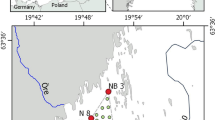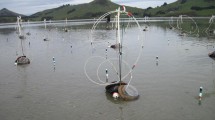Abstract
The decay of non-native and native seaweed mixing may modify sediment biogeochemistry and organic matter transfers within benthic food webs according to their composition and biomass. The non-native species Sargassum muticum was deliberately added to the sediment of an intertidal sandflat at different biomass and mixed to the native species Ulva sp. and Fucus vesiculosus. The sediment porewater was then 13C and 15N enriched to test whether both detrital diversity and biomass influenced the transfer of porewater carbon and nitrogen to the sediment and to the macrofauna consumers. More 15N-nitrogen was mobilized to sediments and macrofauna when the 3-species detrital mixing was buried, probably because this mixing provided species-specific compounds such as polyphenols due to the presence of S. muticum and F. vesiculosus, as well as large amounts of nitrogen due to the presence of Ulva. Our study revealed the importance of detrital diversity and non-native seaweeds for the nitrogen cycling in the benthic food web.




Similar content being viewed by others
References
Banta GT, Pedersen MF, Nielsen SL (2004) Decomposition of marine primary producers: consequences for nutrient recycling and retention in coastal ecosystems. In: Nielsen SL, Banta GT, Pedersen MF (eds) Estuarine nutrient cycling: the influence of primary producers. Kluwer Academic Publishers, The Netherlands, pp 187–216
Bishop MJ, Kelaher BP (2008) Non-additive, identity-dependent effects of detrital species mixing on soft-sediment communities. Oikos 117:531–542
Bishop MJ, Coleman MA, Kelaher BP (2010) Cross-habitat impact of species decline: response of estuarine sediment communities to changing detrital resources. Oecologia 163:517–525
Buchsbaum R, Valiela I, Swain T, Dzierzeski M, Allen S (1991) Available and refractory nitrogen in detritus of coastal vascular plants and macroalgae. Mar Ecol Prog Ser 72:131–143
Byrnes JE, Reynolds PL, Stachowicz JJ (2007) Invasions and extinctions reshape coastal marine food webs. PLoS One 2(3):e295. doi:10.1371/journal.pone.0000295
Carlier A, Riera P, Amouroux JM, Bodiou JY, Grémare A (2007) Benthic trophic network in the Bay of Banyuls-sur-Mer (northwest Mediterranean, France): an assessment based on stable carbon and nitrogen isotopes analysis. Estuar Coast Shelf Sci 72:1–15
Cebrian J (2004) Role of first-order consumers in ecosystem carbon flow. Ecol Lett 7:232–240
Covich AP, Austen MC, Barlocher F, Chauvet E, Cardinale BJ, Biles CL, Inchausti P, Dangles O, Solan M, Gessner MO, Statzner B, Moss B (2004) The role of biodiversity in the functioning of freshwater and marine benthic ecosystems. Bioscience 54:767–775
Fontaine S, Bardoux G, Abbadie L, Mariotti A (2004) Carbon input to soil may decrease soil carbon content. Ecol Lett 7:314–320
Ford RB, Thrush SF, Probert PK (1999) Macrobenthic colonisation of disturbances on an intertidal sandflat: the influence of season and buried algae. Mar Ecol Prog Ser 191:163–174
Godbold JA, Solan M, Killham K (2009) Consumer and resource diversity effects on marine macroalgal decomposition. Oikos 118:77–86
Hattenschwiler S, Gasser P (2005) Soil animals alter plant litter diversity effects on decomposition. Proc Natl Acad Sci USA 102:1519–1524
Herman PMJ, Middelburg JJ, Widdows J, Lucas CH, Heip CHR (2000) Stable isotopes as trophic tracers: combining field sampling and manipulative labeling of food resources for macrobenthos. Mar Ecol Prog Ser 204:79–92
Hooper DU, Chapin FS, Ewel JJ, Hector A, Inchausti P, Lavorel S, Lawton JH, Lodge DM, Loreau M, Naeem S, Schmid B, Setala H, Symstad AJ, Vandermeer J, Wardle DA (2005) Effects of biodiversity on ecosystem functioning: A consensus of current knowledge. Ecol Monogr 75:3–35
Incera M, Olabarria C, Cacabelos E, César J, Troncoso JS (2011) Distribution of Sargassum muticum on the North West coast of Spain: Relationships with urbanization and community diversity. Cont Shelf Res 31:488–495
Kaehler S, Pakhomov EA (2001) Effects of storage and preservation on the Δ13C and Δ15N signatures of selected marine organisms. Mar Ecol Prog Ser 219:299–304
Kelaher BP, Levinton JS (2003) Variation in detrital enrichment causes spatio-temporal variation in soft-sediment assemblages. Mar Ecol Prog Ser 261:85–97
Kominoski JS, Pringle CM, Ball BA, Bradford MA, Coleman DC, Hall DB, Hunter MD (2007) Non-additive effects of leaf litter species diversity on breakdown dynamics in a detritus-based stream. Ecology 88:1167–1176
Meier CL, Bowman WD (2008) Links between plant litter chemistry, species diversity, and below-ground ecosystem function. Proc Natl Acad Sci USA 105:19780–19785
Middelburg JJ, Barranguet C, Boschker HTS, Herman PMJ, Moens T, Heip CHR (2000) The fate of intertidal microphytobenthos carbon: An in situ C13-labeling study. Limnol Oceanogr 45:1224–1234
Moore TN, Fairweather PG (2006) Decay of multiple species of seagrass detritus is dominated by species identity, with an important influence of mixing litters. Oikos 114:329–337
Moore JC, Berlow EL, Coleman DC, de Ruiter PC, Dong Q, Hastings A, Johnson NC, McCann KS, Melville K, Morin PJ, Nadelhoffer K, Rosemond AD, Post DM, Sabo JL, Scow KM, Vanni MJ, Wall DH (2004) Detritus, trophic dynamics and biodiversity. Ecol Lett 7:584–600
Olabarria C, Lastra M, Garrido J (2007) Succession of macrofauna on macroalgal wrack of an exposed sandy beach: Effects of patch size and site. Mar Environ Res 63:19–40
Olabarria C, Incera M, Garrido J, Rossi F (2010) The effect of wrack composition and diversity on macrofaunal assemblages in intertidal marine sediments. J Exp Mar Biol Ecol 396:18–26. doi:10.1016/j.jembe.2010.10.003
Pearson TH (2001) Functional group ecology in soft-sediment marine benthos: the role of bioturbation. Oceanogr Mar Biol Annu Rev 39:233–267
Pedersen MF, Staehr PA, Wernberg T, Thomsen MS (2005) Biomass dynamics of exotic Sargassum muticum and native Halidrys siliquosa in Limfjorden, Denmark—implications of species replacements on turnover rates. Aquat Bot 83:31–47
Ribera MA, Bouderesque CF (1995) Introduced marine plants, with special referente to macroalgae: mechanisms and impact. In: Round FE, Chapman DJ (eds) Progress in phycological Research. Biopress Ltd Publ, New York, pp 187–268
Rice DL, Tenore KR (1981) Dynamics of carbon and nitrogen during the decomposition of detritus derived from estuarine macrophytes. Estuar Coast Shelf Sci 13:681–690
Rodil IF, Olabarria C, Lastra M, Lopez J (2008) Differential effects of native and invasive algal wrack on macrofaunal assemblages inhabiting exposed sandy beaches. J Exp Mar Biol Ecol 358:1–13
Rossi F (2006) Small-scale burial of macroalgal detritus in marine sediments: Effects of Ulva spp. on the spatial distribution of macrofauna assemblages. J Exp Mar Biol Ecol 332:84–95
Rossi F (2007) Recycle of buried macroalgal detritus in sediments: use of dual-labelling experiments in the field. Mar Biol 150:1073–1081
Rossi F, Underwood AJ (2002) Small-scale disturbance and increased nutrients as influences on intertidal macrobenthic assemblages: experimental burial of wrack in different intertidal environments. Mar Ecol Prog Ser 241:29–39
Rossi F, Vos M, Middelburg JJ (2009) Species identity, diversity and microbial carbon flow in reassembling macrobenthic communities. Oikos 118:503–512
Rossi F, Olabarria C, Incera M, Garrido J (2010) The trophic significance of the invasive seaweed Sargassum muticum in sandy beaches. J Sea Res 63:52–61
Stachowicz JJ, Terwin JR, Whitlatch RB, Osman RW (2002) Linking climate change and biological invasions: ocean warming facilitates nonindigenous species invasions. Proc Natl Acad Sci USA 99:15497–15500
Thrush SF (1986) The sublittoral macrobenthic community structure of an Irish sea-lough—effect of decomposing accumulations of seaweed. J Exp Mar Biol Ecol 96:199–212
Underwood AJ (1997) Experiments in ecology: logical design and interpretation using analysis of variance. Cambridge University Press, Cambridge
Urban-Malinga B, Gheskiere T, Degraer S, Derycke S, Opalinski KW, Moens T (2008) Gradients in biodiversity and macroalgal wrack decomposition rate across a macrotidal, ultradissipative sandy beach. Mar Biol 155:79–90
Verlaque M (1994) Checklist of introduced plants in the Mediterranean: origins and impact on the environment and human activities. Oceanol Acta 17:1–23
Veuger B, Middelburg JJ, Boschker HTS, Houtekamer M (2005) Analysis of N-15 incorporation into d-alanine: a new method for tracing nitrogen uptake by bacteria. Limnol Oceanogr Methods 3:230–240
Wolkovich EM, Bolger DT, Holway DA (2009) Complex responses to invasive grass litter by ground arthropods in a Mediterranean scrub ecosystem. Oecologia 161:697–708
Zubia M, Payri C, Deslandes E (2008) Alginate, mannitol, phenolic compounds and biological activities of two range-extending brown algae, Sargassum mangarevense and Turbinaria ornata (Phaeophyta: Fucales), from Tahiti (French Polynesia). J Appl Phycol 20:1033–1043
Acknowledgments
This research has been supported by the Spanish Government through the Ministry of Education and Science-FEDER (PROJECT CGL2006-27880-E) and through the Ministry of Science and Innovation-FEDER (PROJECT CGL2009-07205). Dr. Cristina Docal (IMAR-CMA, Coimbra, Portugal) greatly helped for the isotope analyses. Comments on the manuscript by two anonymous referees greatly improved the manuscript.
Author information
Authors and Affiliations
Corresponding author
Additional information
Communicated by M. Huettel.
Rights and permissions
About this article
Cite this article
Rossi, F., Incera, M., Callier, M. et al. Effects of detrital non-native and native macroalgae on the nitrogen and carbon cycling in intertidal sediments. Mar Biol 158, 2705–2715 (2011). https://doi.org/10.1007/s00227-011-1768-6
Received:
Accepted:
Published:
Issue Date:
DOI: https://doi.org/10.1007/s00227-011-1768-6




